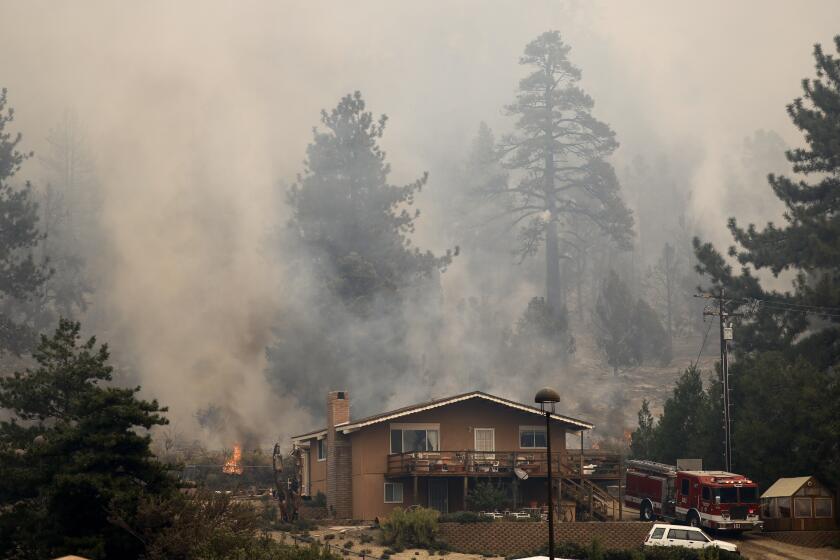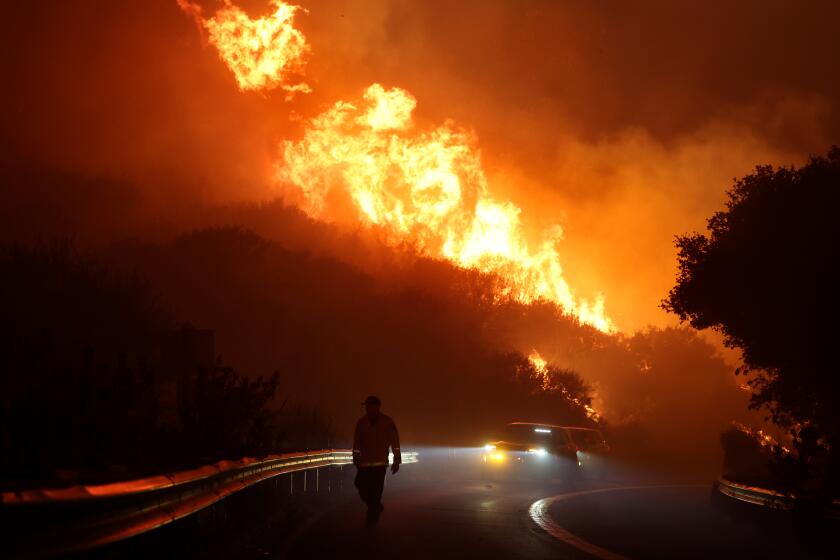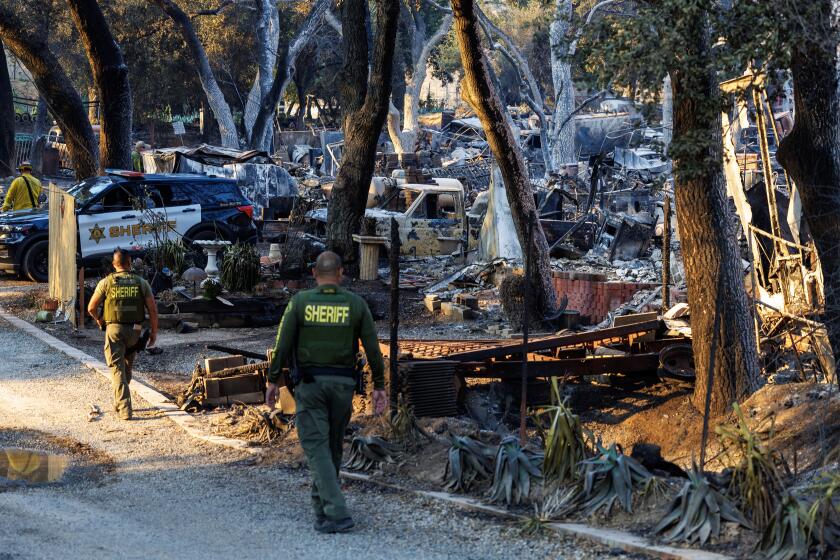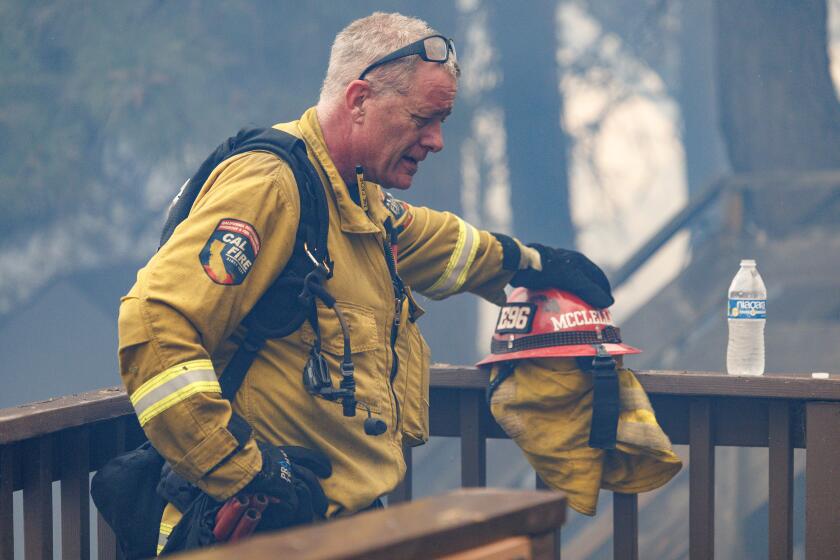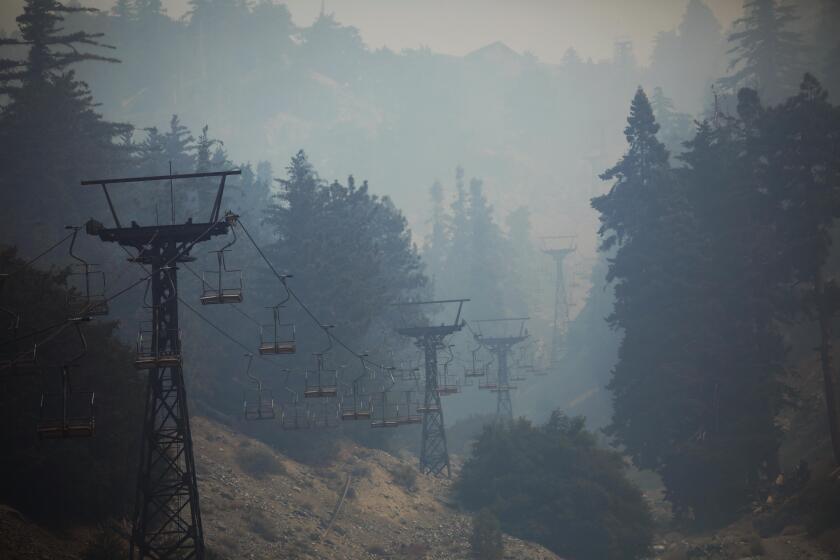Firefighters gaining control over destructive Southern California wildfires
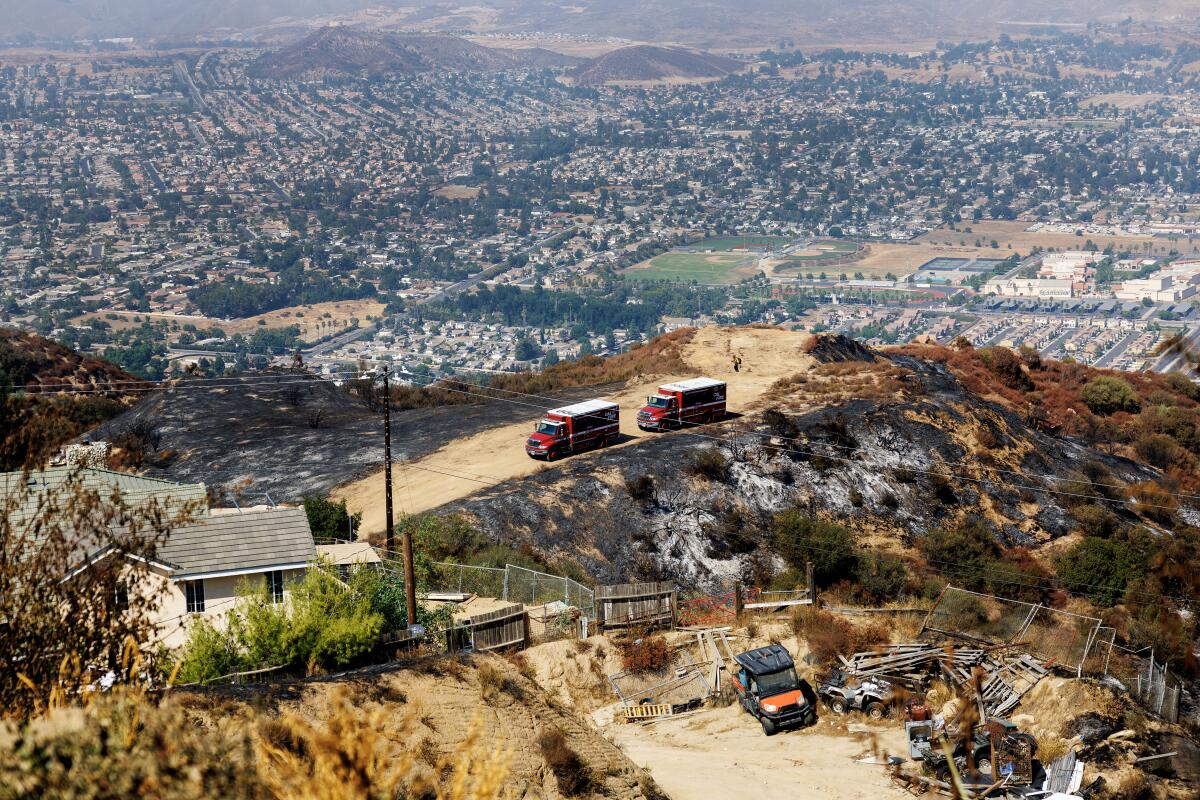
- Share via
Bit by bit, and with a little help from the weather, firefighting crews in Southern California are gaining control over three blazes that have destroyed dozens of buildings, burned more than 100,000 acres and kept countless residents out of their homes for days.
Cooler temperatures have helped firefighters on the ground slow down the fires’ rapid pace and make significant gains, but crews are not letting their guard down.
“We’re not letting the weather deceive us,” said Kenichi Haskett, Los Angeles County Fire Department public information officer for the Bridge fire. “I know the weather is cooperating, but we’re still challenged with steep conditions.”
On Friday, containment of the 52,801-acre Bridge fire increased to 3% after days of flames marching north over the Angeles and San Bernardino national forests with crews unable to contain any of the fire’s perimeter. More than 5,000 structures remain threatened by the flames and dozens of buildings have been destroyed. At least 13 homes in Wrightwood have burned along with cabins in the surrounding area.
The 48,000-acre Bridge fire, which remains uncontained, has become the largest and highest-priority fire in California, officials said.
Firefighters there — and to the east fighting the Line fire and to the south battling the Airport fire in Orange and Riverside counties — had been counting on a break from days of extreme heat and low humidity as an opportunity to start to corral the out-of-control blazes.
Firefighters on the Bridge fire were focusing their attention Friday on its north flank, protecting the communities of Piñon Hills, Wrightwood and Mount Baldy Village, Haskett said.
Officials on Friday afternoon also started to roll back evacuation warnings in San Bernardino County, as the fire threat to some communities began to subside.
Though conditions have improved, Haskett said firefighters are still dealing with steep, rugged terrain, making it difficult to access areas and build containment lines.
Here’s a quick guide to many of the terms commonly used in connection with wildfires and public safety in the face of the dangers posed.
Dry brush and vegetation have also helped fuel erratic fire behavior, with flames quickly spreading and at times changing direction.
There’s a possibility of light rain on Sunday night and Monday morning.
“That will help to some extent lower the temperatures and raise the humidity, but that doesn’t mean the fire is out,” Haskett said. “They still need to go stump by stump, and rock by rock.”
From Wednesday to Friday, containment of the Line fire in San Bernardino County rose to 25%. By Friday night, the fire had burned 38,074 acres, according to the California Department of Forestry and Fire Protection website.
This week, a 34-year-old Norco man was arrested on suspicion of starting the Line fire and was charged with multiple counts of arson. Prosecutors say Justin Wayne Halstenberg tried to start the fire several times before it eventually took off.
Multiple people have been arrested in neighborhoods evacuated due to wildfires. Officials said one pair had items that would aid them in carrying out thefts — as well as, strangely, wild opossums.
His mother, Connie Halstenberg, told The Times her son is innocent.
“He did not light that fire, I repeat, he did not light that fire,” she said.
The Orange County health officer issued a declaration of local health emergency for areas affected by the Airport fire Friday, while the Angeles National Forest increased the fire danger level to “extreme.” Forest activity restrictions include no campfires, use of grills, portable lanterns, stoves or smoking.
Multiple arrests have been made in areas under evacuation orders this week, including two men in Running Springs on Wednesday. Two men were arrested in Big Bear Lake on Thursday on suspicion of trespassing and unauthorized entry to a closed emergency area. Another pair were arrested Wednesday in the community of San Antonio Heights, which is under an evacuation warning due to the Bridge fire.
Fire officials credited the weather, especially higher moisture levels, with helping crews to build containment lines as the fire has slowed.
This weekend, firefighters hope, some of those favorable conditions will continue.
Temperatures will cool throughout the weekend and the rest of next week in the fire areas, said Sam Zuber, meteorologist with the National Weather Service in San Diego.
“We’ve been pretty lucky here that we’ve entered this prolonged cooler period, and everyone is thankful that they’ve been able to make gains on the fire,” Zuber said.
The wildfires burning in Southern California are heightening a nationwide shortage of firefighters, aircraft and contractors to fight these blazes.
Into next week, high temperatures are expected to be in the upper 70s or low 80s, about 10 degrees below usual for this time of year, she said. In the high peaks of the San Bernardino Mountains, temperatures may top out in the 40s by Monday.
Monday could even come with a chance of some rain near the Bridge fire, Zuber said, with about a tenth of an inch of rain possible that day. The amount of rain is not expected to present a risk of mudflows in the burn areas.
Relative humidity is also expected to increase, to up to 60% by Monday, which could further hamper the fire’s growth.
“The fire will struggle to burn in humidity that high,” she said.
The impending arrival of hot Santa Ana winds, combined with two years of overgrown vegetation, could pave the way for a fiery fall.
The only concern, Zuber said, is that the lower temperatures could also bring stronger winds of about 20-25 mph starting Sunday.
And the fire still poses a threat. Officials pointed out that patches are still smoldering and flames are making occasional runs on slopes and drainages, using dry vegetation as fuel.
More than 65,000 structures are still threatened by the blaze, officials said.
“The focus is to build direct and indirect [fire] lines,” said Fabian Herrera, spokesperson for the Line fire unified command, which includes Cal Fire and San Bernardino National Forest.
The priority is to cut off the fire’s progress in the north, and keep it a safe distance from communities, Herrera said.
“The forecast into the weekend and early next week seems to be very positive, but that can all change if the weather patterns shift or winds pick up,” he said.
California’s ski resorts are in the path of several fires, prompting concerns about damage to the popular destinations.
Crews fighting the Line, Bridge and Airport fires are also sharing air resources dropping water and fire retardant on the three major wildfires, he said.
Damage inspection teams have also begun to enter communities to assess the effects of the fires, he said, but there was no estimate of the total cost of the firefighting effort.
So far, three structures have been damaged by the Line fire, and one has been destroyed. In the Airport fire, 22 structures have been destroyed, and three more have been damaged.
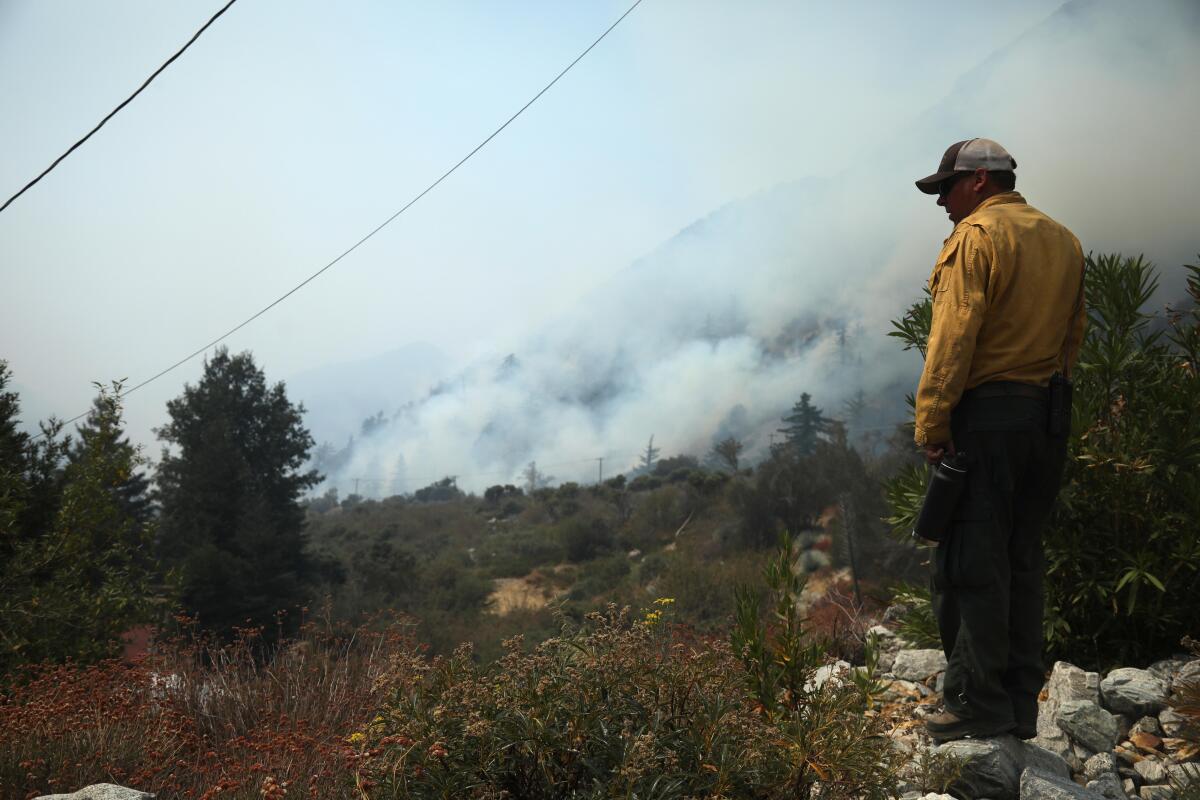
The Airport fire’s containment also increased Friday, climbing to 9%. The blaze was listed at 23,494 acres. Teams there are assessing how many homes were destroyed in El Cariso Village, tucked in the Santa Ana Mountains, after the fire jumped Ortega Highway earlier in the week and ran through the small community.
On Thursday, authorities there started to scale back evacuations as the weather turned in their favor, including for some residents in Lakeland Village near Lake Elsinore, and Rancho Carrillo in Riverside County.
In Orange County, residents along Ortega Highway up to the Nichols Institute were allowed to return as a mandatory evacuation order was downgraded to a warning.
Times staff writer Ashley Ahn contributed to this report.
More to Read
Sign up for Essential California
The most important California stories and recommendations in your inbox every morning.
You may occasionally receive promotional content from the Los Angeles Times.
